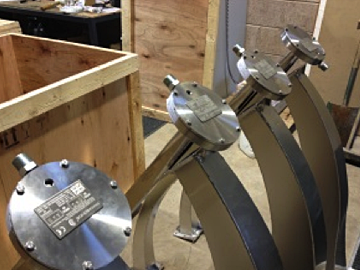So what are Sonic Soot Blowers?
They are pneumatically operated horns that produce low frequency – high energy sound waves. These sound waves are produced when compressed air enters the Wave Generator and forces the only moving part, a titanium diaphragm, to flex. Sonic Soot Blowers are employed wherever ash, dust, powders or granular materials are processed, generated, stored or transported.
The Quattrosonic Sonic Soot Blowers were designed as a replacement for the somewhat primitive and abrasive boiler tube cleaning Steam Soot Blower systems used in Power Industries, but are just as effective in Bulk Solids Processing and Transporting industries too.
How do they work?
Sonic Soot Blowers are extremely simple in their operation, requiring only normal plant compressed air for their initial energy source. Compressed air enters the Wave Generator and forces the only moving part, the ultra-high grade titanium diaphragm to oscillate very rapidly within its specially designed housing. These rapid oscillations create the base tone and the different body sections convert, amplify and distribute this base tone into a range of selected key fundamental frequencies. Sonic Soot Blowers produce very rapid sonic sound pressure pulses (up to 350 per second) which produce in turn, a positive (+) ‘push’ followed by a negative (-) ‘pull’ effect which weakens the bond between the particles themselves and the surface to which they are adhered to. This then causes these adherence bonds to break thus dislodging the particles which are then removed either by gravity or in the gas stream.
Cleaning Efficiency – because Sonic Soot Blowers use powerful sonic sound waves, these sound waves travel at a speed of 344 meters per second and in a 360° radius. This means that the entire circumference of the tubes and internal structure can be easily reached instead of just the leading edge of the tubes as with a steam soot blower. A periodic ‘sonic sounding’ is all that is required to achieve these goals -typically 5 – 10 seconds every 6 – 12 minutes.
Continuous plant operation is possible because particulate build-up is eliminated. By strategically placing the Sonic Soot Blower they will eliminate the need for operators to enter potentially hazardous and dangerous areas of processing plant to carry out manual cleaning.
Primasonics have successfully installed their range of Sonic Soot Blowers within the Solids Handling Industries in;
* Silos * Boilers
* Hoppers * Superheaters
* Filters * Economisers
* Ductwork * Air Heaters
* Fans * SCR’s
* Cyclones * ESP’s
* Air Classifiers
Can Sonic Soot Blowers be easily retrofitted?
Indeed they can, in fact most of our sales are to end users or engineering companies who wish to install Sonic Soot Blowers to replace either unreliable or inefficient steam/water soot blowers. Therefore, we can usually use the access point left vacant by the removal of the rotary or retractable steam soot blowers where possible or else mount the Sonic Soot Blowers on any available hatches. Installation of Sonic Soot Blowers is quick and easy.
Why do Sonic Soot Blowers come in a range of frequencies?
Each particular sound frequency has its own individual sound wave pattern. The higher the sound frequency the shorter the sound wave and the lower the frequency the longer the sound wave. We have therefore carefully selected five different specific sound frequencies (350 – 230 – 120 – 75 & 60 Hz) for our range of Sonic Soot Blowers because these five different frequencies will provide effective particulate de-bonding over a wide range of applications and plant sizes.
For further information contact Primasonics International Ltd by:-
Tel: 44 (0) 1768 866648
Email: sound@primasonics.com
Web Page: www.primasonics.com














